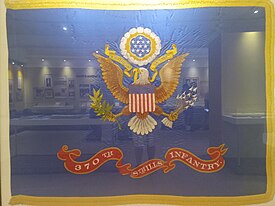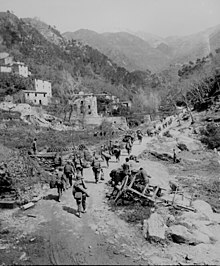
The 3rd Infantry Division (3ID) is a combined arms division of the United States Army based at Fort Stewart, Georgia. It is a subordinate unit of the XVIII Airborne Corps under U.S. Army Forces Command. Its current organization includes a division headquarters and headquarters battalion, two armored brigade combat teams, one aviation brigade, a division artillery, a sustainment brigade and a combat sustainment support battalion along with a maneuver enhancement brigade. The division has a distinguished history, having seen active service in World War I, World War II, the Korean War, and the Global War on Terror. The Medal of Honor has been awarded to 61 members of the 3rd Infantry Division, making the division the most honored in the Army.

The 7th Infantry Division is an active duty infantry division of the United States Army based at Joint Base Lewis-McChord charged with sustaining the combat readiness of two Stryker brigade combat teams (BCT), a combat aviation brigade, and a Division Artillery Unit, as well as participating in several yearly partnered exercises and operations in support of U.S. Army Pacific and the Indo-Pacific region. The 7th Infantry Division is the only active-duty multi-component division headquarters in the Army. The 7th Infantry Division is also home to two of the Army's newest enabling battlefield capabilities, the Multi Domain Task Force and the Intelligence, Information, Cyber, Electronic Warfare and Space Capabilities, or I2CEWS battalion.

The 369th Infantry Regiment, originally formed as the 15th New York National Guard Regiment before it was re-organized as the 369th upon its federalization and commonly referred to as the Harlem Hellfighters, was an infantry regiment of the New York Army National Guard during World War I and World War II. The regiment mainly consisted of African Americans, but it also included men from Puerto Rico, Cuba, Guyana, Liberia, Portugal, Canada, the West Indies, as well as white American officers. With the 370th Infantry Regiment, it was known for being one of the first African-American regiments to serve with the American Expeditionary Forces during World War I.
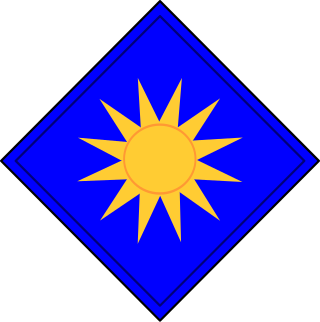
The 40th Infantry Division is a modular division of the United States Army. Following the army's modularization the division has become a four-brigade combat team with National Guardsmen from throughout the Pacific/Western United States and Oceania. Its division headquarters is located at Los Alamitos Joint Forces Training Base in Los Alamitos, California.

The 86th Infantry Division, also known as the Blackhawk Division, was a unit of the United States Army in World War I and World War II. Currently called the 86th Training Division, based at Fort McCoy, Wisconsin, members of the division now work with Active Army, Reserve, and National Guard units to provide them with a Decisive Action Training Environment on a yearly basis.

The 92nd Infantry Division was an African American, later mixed, infantry division of the United States Army that served in World War I, World War II, and the Korean War. The military was racially segregated during the World Wars. The division was organized in October 1917, after the U.S. entry into World War I, at Camp Funston, Kansas, with African American soldiers from all states. In 1918, before leaving for France, the American buffalo was selected as the divisional insignia due to the "Buffalo Soldiers" nickname, given to African American cavalrymen in the 19th century. The divisional nickname, "Buffalo Soldiers Division", was inherited from the 366th Infantry, one of the first units organized in the division.

The 93rd Infantry Division was a "colored" segregated unit of the United States Army in World War I and World War II. However, in World War I only its four infantry regiments, two brigade headquarters, and a provisional division headquarters were organized, and the divisional and brigade headquarters were demobilized in May 1918. Its regiments fought primarily under French command in that war and saw action during the Second Battle of the Marne. They acquired the nickname Blue Helmets from the French, as these units were issued horizon blue French Adrian helmets. Consequently, its shoulder patch became a blue French helmet, to commemorate its service with the French Army during the German spring offensive.

The 6th Infantry Division was an infantry division of the United States Army active in World War I, World War II, and the last years of the Cold War. Known as "Red Star", it was previously called the "Sight Seein' Sixth".

The 34th Infantry Division is an infantry division of the United States Army, part of the National Guard, that participated in World War I, World War II and multiple current conflicts. It was the first American division deployed to Europe in World War II, where it fought with great distinction in the Italian Campaign.

The 33rd Infantry Division was a formation of the U.S. Army National Guard between 1917 and 1968. Originally formed for service during World War I, the division fought along the Western Front during the Battle of Amiens, the Battle of Hamel, the Meuse-Argonne Offensive, at the Second Battle of the Somme, and at the Battle of Saint-Mihiel. It was re-formed during the inter-war period, and then later activated for service during World War II, seeing action against the Imperial Japanese Army in the Pacific. In the post war era, the division was reconstituted as an all-Illinois National Guard division. In the late 1960s, the division was reduced to a brigade-sized formation, and its lineage is currently perpetuated by the 33rd Infantry Brigade Combat Team.

The 85th Infantry Division also known as "Custer Division" was an infantry division of the United States Army in World War I and World War II. It currently exists as the 85th Support Command.
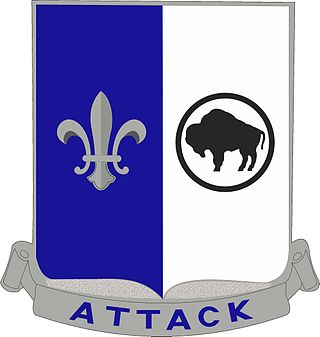
The 371st Infantry Regiment was a segregated African American regiment, nominally a part of the 93rd Division, that served in World War I under French Army command, and also in World War II in the Italian Campaign as part of the 92nd Infantry Division (Colored).
The 366th Infantry Regiment was an all African American (segregated) unit of the United States Army that served in both World War I and World War II. In the latter war, the unit was exceptional for having all black officers as well as troops. The U.S. military did not desegregate until after World War II. During the war, for most of the segregated units, all field grade and most of the company grade officers were white.
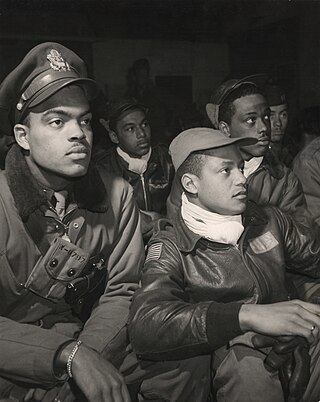
The military history of African Americans spans from the arrival of the first enslaved Africans during the colonial history of the United States to the present day. African Americans have participated in every war fought by or within the United States, including the Revolutionary War, the War of 1812, the Mexican–American War, the Civil War, the Spanish–American War, World War I, World War II, the Korean War, the Vietnam War, the Gulf War, the War in Afghanistan, and the Iraq War.

The 184th Infantry Regiment is an infantry regiment of the United States Army consisting of soldiers from the California Army National Guard. Only the regiment's 1st Battalion remains an active military unit. The battalion supports state and federal missions in the State of California, United States of America and at overseas locations. The 184th Infantry Regiment can trace its lineage to the mid-19th century.

The 106th Cavalry Regiment was a mechanized cavalry unit of the United States Army in World War II recognized for its outstanding action. The group was organized in 1921 as part of the Illinois National Guard and during the Spanish–American War and World War I was known as the 1st Regiment Illinois Volunteer Cavalry. It underwent a number of reorganizations before World War II. Like other Guard units during the inter-war years, the 106th held weekly or monthly drills and yearly training. Readiness for war in 1940 led to the mechanization of the unit and induction into federal service at Camp Livingston, Louisiana on 25 November 1940.

The Battle of Garfagnana, known to the Germans as Operation Winter Storm and nicknamed the "Christmas Offensive", was a successful Axis offensive against American forces on the western sector of the Gothic Line during World War II. It took place in December 1944 in the north Tuscan Apennines, near Massa and Lucca.

Otis Beverly Duncan was an officer in the United States Army. He was the highest-ranking African American in the American Expeditionary Forces at the end of World War I, serving as a lieutenant colonel in the 370th Infantry Regiment. His regiment was the only combat unit commanded by African American officers.
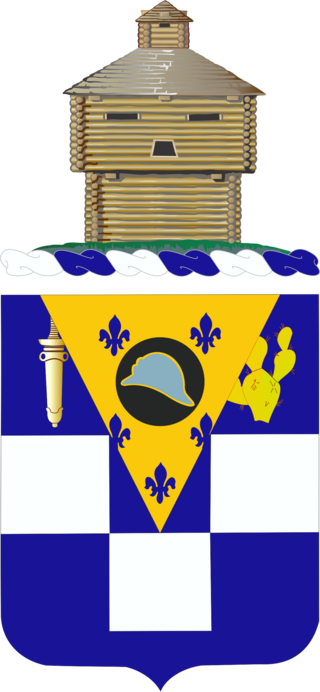
The 178th Infantry Regiment is an infantry regiment of the United States Army, Illinois Army National Guard. It traces its history back to the Illinois state militia and has served in several American wars since its founding. The regiment is unique because its original members were part of a segregated "colored" unit. The regiment's 1st Battalion still exists today as an Air assault battalion.
The 122nd Field Artillery Regiment is a field artillery regiment of the Illinois Army National Guard. The regiment's 2nd Battalion is the cannon battalion assigned to the 33rd Infantry Brigade Combat Team.
